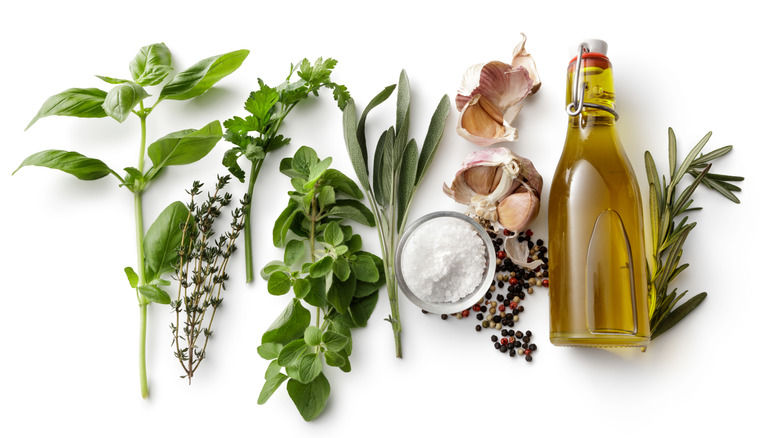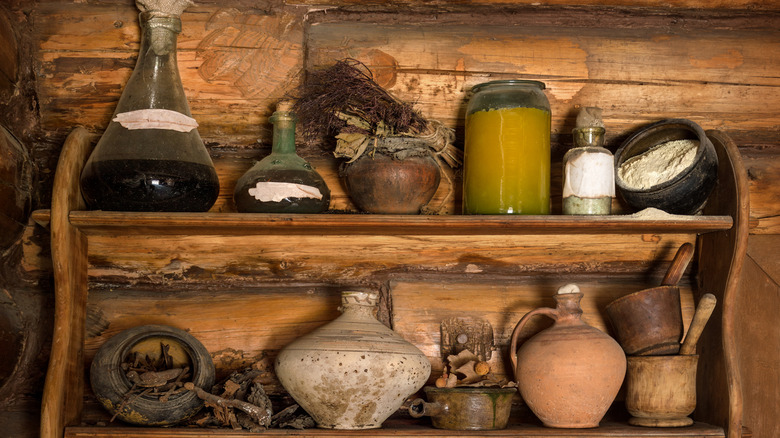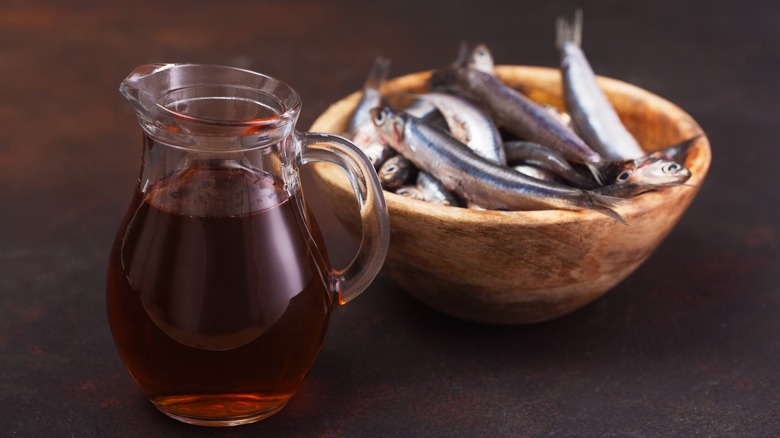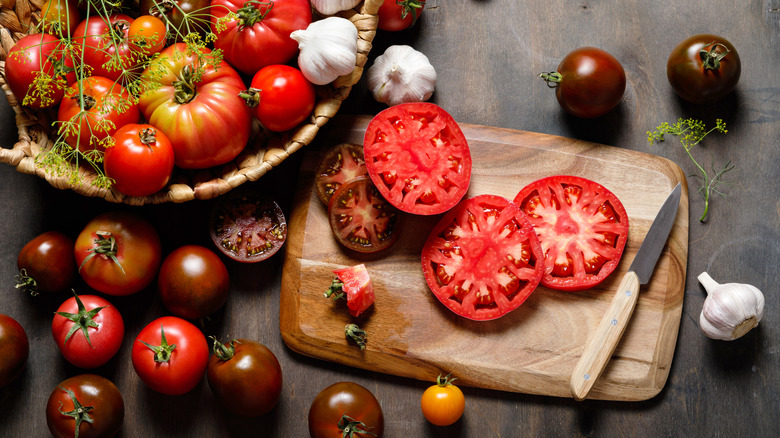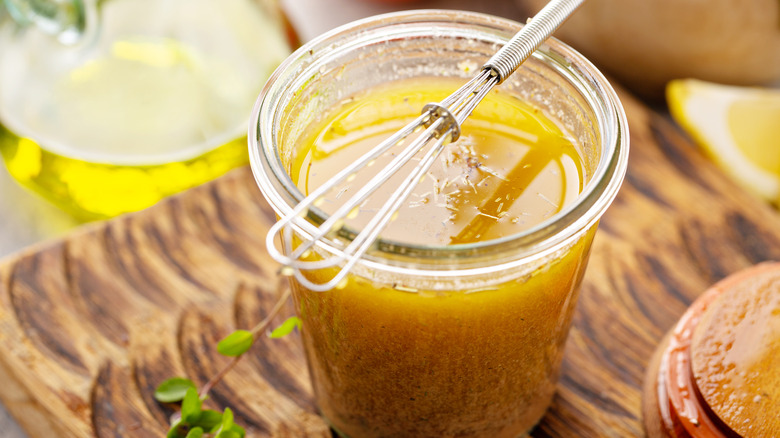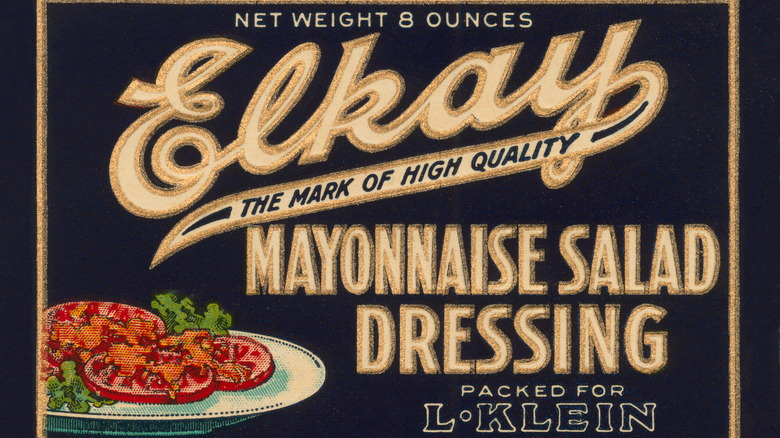The Ancient Babylonian Beginnings Of Salad Dressings
While recent archeological excavations may have recently proven that a recognizable, oil-based form of salad dressing has been around for at least 2,000 years, knowledge of other ancient civilizations shows that people may have been tossing salads well before that. For example, Chinese soy sauce was used as a dressing closer to 5,000 years ago and became a favored topping linked with Japanese seaweed salad's early origins.
Packed with nutrients and simple to throw together, salads have been a dietary staple across cultures for millennia, and have always been dressed with something piquant to give them an enticing flavor. Dressing has been around just about as long as salad itself, suggesting one can't really exist without the other.
For many, dressing is what makes a salad, a mindset that hasn't changed much in a few thousand years. Though there may be polarizing opinions on what is proper or best for dressing a salad, the baseline ingredients used to spruce up greens haven't changed very much either. Oil and vinegar, an easy combination to whip up at home, was the same concoction widely used and enjoyed in the Ancient World.
Origins in Babylon
Though people in China and Egypt may have eaten salad first, it is the Babylonians who finessed salad dressing. Two-thousand years ago, Babylon was serving green salads very similarly to the way we might eat them today. To season their salads, they preferred a simple mixture of oil and vinegar, a combination that has withstood the test of time.
Babylonian agriculture thrived with the man-made system of canals and levees that brought reliable irrigation via the nearby Euphrates River. This allowed for garden plots to produce an abundance of lettuce and arugula as greens regularly consumed within Babylon's city walls. Consequently, Babylon's salads would not have looked very different from any bowl of superfood greens currently served in contemporary restaurants.
The vinegar that Babylonians poured as salad dressing was also used as a medicinal tonic. Though it is not known whether the Babylonians considered salad a health food, their well-dressed salads certainly provided them with a rich and varied diet.
Roman dressing gave salad its name
"The Romans were enthusiastic eaters of salads," John Ayto writes in "An A-Z of Food and Drink" (via Food Timeline). They often ate salad in the form of salt sprinkled over greens. This simple dish of salted herbs had a straightforward name – herba salata – which eventually (and etymologically) evolved, according to the "Oxford Companion to Food," into "Old French as salade and then in late 14th century English as salad or sallet" (via Food Timeline).
Though the various salads of antiquity remained relatively uncomplicated selections of raw vegetables tossed together, their dressings transformed into increasingly more complex mixtures. Classical salad dressings came to include oil, vinegar, and brine, though more creative recipes may have incorporated honey, wine, and garum (a fermented fish sauce the Romans were crazy about).
Though an infamous Roman emperor bears the same name as a popular contemporary lettuce-based dish, ancient Rome's dressings have no associations with how Caesar salad got its name. There is, however, one curious commonality between the two — they both contain anchovies. This fish — once salted the ancient Roman way — released a pickling liquid called liquamen, which, when left to ferment, became the garum that was then used as a prized condiment and favored dressing. Whether coincidental or by design, Rome's garum legacy lives on in the anchovies that remain a well-known secret to Caesar dressing's unique taste.
Vinaigrette takes many forms
The Romans introduced numerous culinary staples when they invaded Britain in A.D. 43. Many of their edible imports were plants that produced fruits and vegetables Britain had never seen before. Among these was cucumber, a prime salad ingredient that required its own dressing. Deviating little from the Roman preference for oil and vinegar, a popular take on this dressing became known as vinaigrette. John Evelyn discusses it as the recommended dressing for a cucumber salad in his 1699 book, "Acetaria: a Discourse of Sallets." This was the first written record of vinaigrette in an English text, and the recipe calls for oil, lemon or orange juice, vinegar, salt, and pepper. Though not certifiably of French origin, vinaigrette came to be known in Britain as "French dressing," and garnered transatlantic popularity by the end of the 19th century.
Though Rome's salads were an instant hit in northern Europe, the Roman standard of good hygiene did not find equal influence. For this reason, daily life in Europe before indoor plumbing could be quite smelly, due to the foul odors of unwashed bodies and discarded sewage. Largely during the 18th and 19th centuries, vinaigrettes took on an alternate identity as the name for portable perfume boxes that harbored sponges soaked in vinegar mixed with herbs, which could be given a quick sniff when passing through a particularly odorous part of town. The ingredients in these vinaigrettes bore a remarkable similarity to the popular salad dressings of the time.
How to dress a salad in Britain
Though vinaigrette may have been considered a French dressing, British culinary authorities developed a uniquely English methodology for properly dressing salad with this tincture. "This is ... to be tossed thoroughly but lightly, until every portion glistens," Sir Henry Thompson instructs in his informational text, "Food and Feeding," first published in 1818. He goes on to conclude that "only immediately before serving, one small tablespoonful of ... Italian red wine-vinegar is to be sprinkled over all, followed by another tossing of the salad." Though Sir Henry Thompson concedes that making a salad is no great art, he emphasizes that such dishes are easy to mess up. The vegetables must be properly fresh and washed (but not to the point of becoming soggy), and the ingredients within a salad should stick to simplicity – when building a salad, less is more, a belief that continues today. Tomatoes, though the "prince of salads," were of special concern, as they would disrupt the proportion of liquid over greens if cut too soon, and must therefore be sliced and placed just before the salad is served.
Whether company was expected or a meal was just among the family at home, Thompson voices suspicion in setting household staff to the task of properly dressing and tossing a salad. "It should be made by the hostess, or by some other member of the family, immediately before the meal," he asserts. "Very few servants can be trusted."
Dressing in the French style
Though vinaigrette is, according to the "Larousse Gastronomique" (via Food Timeline) a "typically French sauce," vinaigrette's true origins are more likely Italian, perhaps through a greater influence from Ancient Rome. While the ingredients may have culminated across the Alps first, the name that stuck is French. The "vinegar" in vinaigrette comes from vin aigre, translating from French to "sour wine," which is exactly how vinegar was once upon a time first discovered – forgotten wine that fermented and turned sour.
Irrespective of vinaigrette's official origins, the French across the Channel had developed their own method for dressing a salad, which may have required a more liberal portion of oil and vinegar than English methods. "The salad should be saturated with oil, and seasoned with salt and pepper, before the vinegar is added," an 1864 edition of The Saturday Evening Post reports of French chemist Jean-Antoine Chaptal's instructions. In his advice on how to make vinaigrette, the proportions do not require absolute precision, as Chaptal asserts that "there can never be too much vinegar" since any excess would find its way to the bottom of the salad bowl. This was why seasonings were first to be mixed and dissolved in the oil rather than the vinegar, as this would ensure a more even distribution of flavor. Chaptal also emphasizes that wine vinegar is the only appropriate variety for dressing a salad, a hint that French and English dressing methodologies may not have been so different after all.
The 1920s' Salad Dressing Revolution
Until the turn of the 20th century, salad dressings were made from scratch, but this method changed with the introduction of bottled dressing. Among the major contributors to this burgeoning industry was Joe Marzetti of Columbus, Ohio, who, around 1919, sold pre-prepared dressings from local home recipes. A few years prior, Richard Hellman met instant success with his packaged Hellman's blue ribbon mayonnaise, graduating quickly from wooden containers to glass jars. Bigger companies like Kraft soon found their way in, introducing their version of French dressing in 1925, which built upon the foundational ingredients of vinaigrette with added tomato and paprika.
The innovation of ready-made dressing set the stage for a salad renaissance in the 1920s and led to the proliferation of new and increasingly more adventurous flavor combinations. "Salad dressings metamorphosed this century," Jean Anderson writes in "American Century Cook Book" (via Food Timeline). "Busy cooks loved these 'convenience' dressings. In fact, many considered them superior to anything they themselves could make." The demand for salad grew to such an extent during this decade that it carved out a new niche for cookbooks. Like "Bettina's Best Salads and What to Serve With Them," published in 1923, many of these books were dedicated entirely to the preparation of salads and salad dressings. This led to the standardization of many dressings that persist in popularity today, such as Thousand Island, Green Goddess, and the almighty Caesar.
